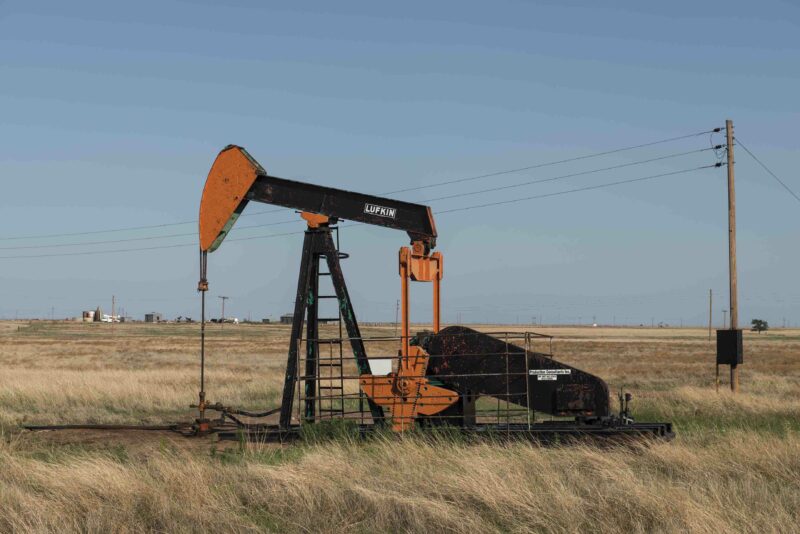Leave the spill and spread of Austin, now the tenth-biggest city in the country, and enter the vast space of rural Texas, fabled for its guns and space rockets. Take State Highway 123 south until it narrows into a thin two-lane road with a sporadic seventy-five-mile-per-hour speed limit and strings of teetering 18-wheelers. Pass the Bender Exotic Game Ranch (now defunct, but where I once spotted a zebra trying to get around the barbed wire). By then you’ll be coasting over the Eagle Ford Shale, a sedimentary rock formation first drilled in 2008 and that has since yielded 3.6 billion barrels of oil. Eagle Ford Shale is approximately fifty miles wide and four hundred miles long, a stretch of fracking and gas extraction infrastructure that you could drive through all day: oil pads, power plants, pumping stations, pipelines, wastewater disposal wells, processing plants, refineries, compression stations—all the ordnance of a war being waged against the earth, air, water, and life.
Life: There are four maximum-security state prisons tucked into this production/destruction zone. Of the hundred state penitentiaries in Texas, 70 percent are partly or fully un-air-conditioned in the housing areas, including these four prisons. If you look at the map of the Eagle Ford Shale on the Texas.gov Railroad Commission website and find the spot in southeast Texas where the dots—each representing a drilling well—are so dense you can’t even read the name of the county underneath, you’ve found the location of the prison where I’ve directed a small creative-writing program since 2015. My students and their cellmates wait out their long sentences amid a mess of fossil-fuel pipelines and drilling wells, literally trapped in giant hot boxes of concrete, steel, and razor wire in climate change–era Texas heat, where, without air-conditioning, they could quite possibly bake to death.
The landscape here is already a replacement. These prickly bushes are not thousand-year-old creosote. This area was part of the great savanna grasslands that for millennia covered large parts of the southeastern United States. Tall grasses and widely spaced trees soaked in the rain and supported an array of birds, bison, frogs, and hundreds of animals of the Coastal Plain Floristic Province. In Texas, the savanna mostly disappeared a century ago, after a few dozen years of cattle overgrazing and fire suppression. Now it is sticky brushland, spiny plants, and mesquite trees that don’t capture the rain—a completely different ecosystem, drier and harsher.
Then the fracking and extraction began—only fifteen years ago—and the plundering turned catastrophic, biblical: habitats systematically cleared, water tables draining. And flaring: we suck oil out of the ground and burn the parts we don’t want, spewing black carbon soot, heavy metals, and sulfur oxides that travel on the wind. At night, in the distance, you can see the flares around Eagle Ford, a hot glow and a low roar on the horizon that make me think of hell.
Perhaps the most bizarre of the oil industry’s eccentricities are wastewater injection wells. Fracking uses massive amounts of water treated with chemicals and combined with sand. The water comes back out, used and polluted, and must be put somewhere. Companies drill special wells, take that used water, and shoot it back into the ground, creating submerged toxic-waste pits that could find their way into the groundwater. It also causes earthquakes. We are literally injecting streams of poison into the earth with such force that we are destabilizing existing faults under our feet, breaking the earth’s crust in our mad rush to get more oil, more, more, more.
Of course, there is little incentive to change, considering all the jobs involved, between the workers and the executives and how they all have to eat and sleep and drink. Besides, are we ready to give up flying?
“Clean energy” poses its own problems. Texas produces the most solar power in the nation after California. But large solar fields are a disaster for the environment. They require ground completely cleared of vegetation: tens of thousands of acres of habitat razed, leaving a chilling, creepy monocrop of metal that will wear out in thirty years and become landfill. I think it won’t be long before all that’s left of this land, which until recently was a biodiverse, thriving-animal savanna, will be a poisoned, dried-out carcass strewn with machinery, trucks, contaminated garbage, and incarcerated people gasping in the heat, or dying as they wait for their sentences to end.
Humanity’s error seems to me to be ownership, that we believe everything is ours—the ground and what’s under it, the air and the water and any life residing in them. We are witnessing the slow winding down, the consequences of this error, who and what are being sacrificed.
If you drive a little farther, take a few turns, leave the highway, and go down one small road and then another, you’ll begin to feel far from the wreckage. Eventually you’ll arrive at Barnhart Q5 Ranch, a seven-hundred-acre nature retreat. It’s run by Claire Barnhart and Wilfred Korth, a retired chief ranger with the Guadalupe-Blanco River Authority. They are nurturing the brushland, the grasses, the wildflowers, the cacti, and the thorny brush. You can stay in an Airbnb on the property and photograph the neotropical birds that, due to climate change, are moving into the area. You can wander the ranch trails. I’ve stayed at this oasis several times while doing longer stints at the prison. In the evenings, I’ve walked up to the stargazing platform to watch the sunset all around me. At night, in one direction in the distance, you can see the dim hint of the industrial glow of flaring. The sound is just barely audible under the chorus of crickets singing their ancient songs.





